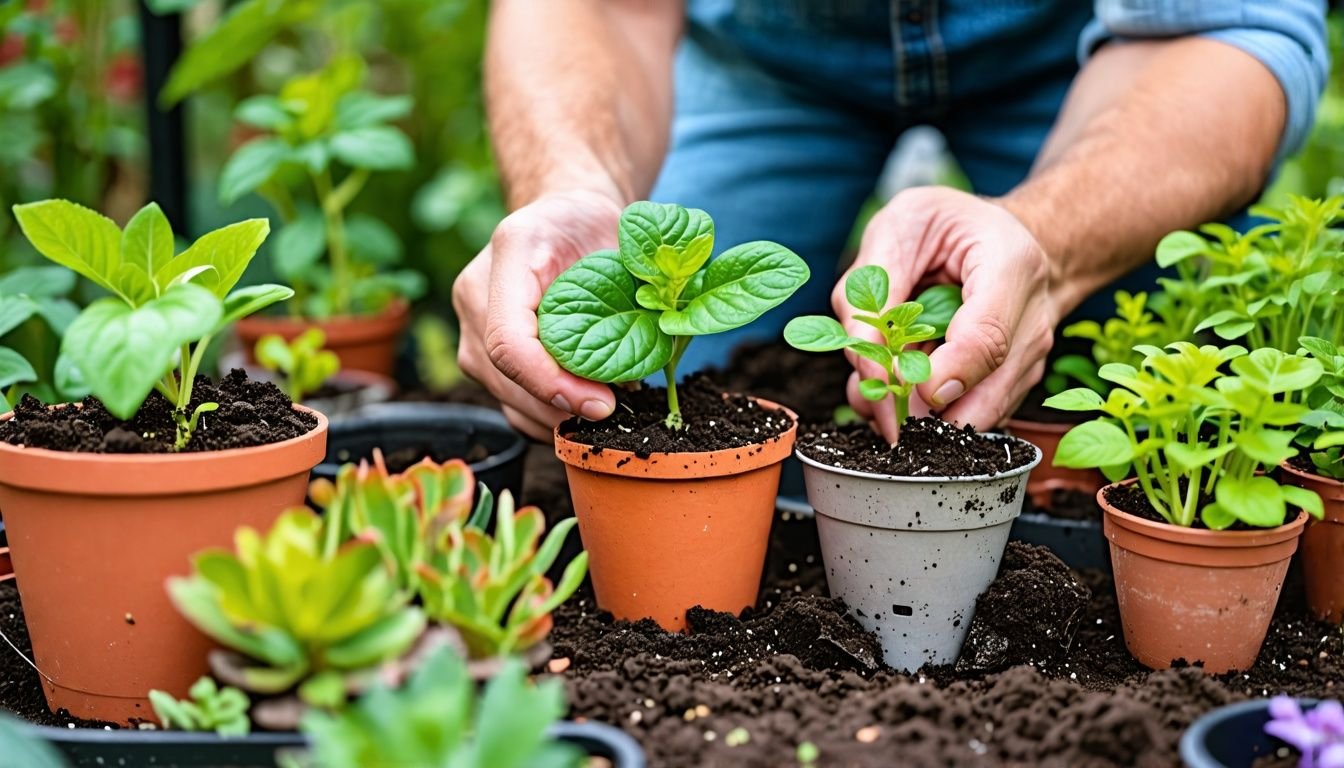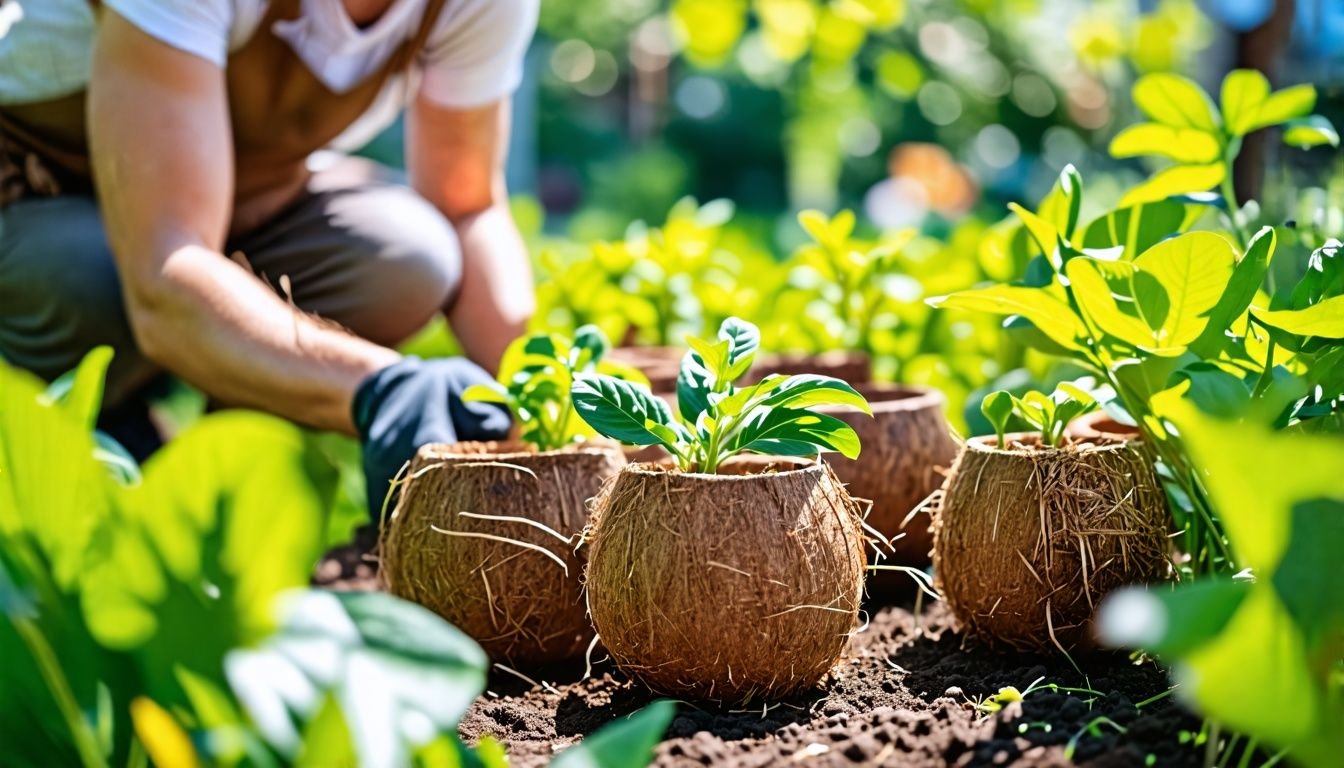G’day, fellow gardeners! Choosing the right seedling pots for your home patch can be a bit of a pickle. Many green thumbs struggle to find containers that support healthy plant growth and are eco-friendly.
We’ve all been in that boat, facing the same challenge in our own gardening adventures.
We get your frustration, mate. After a fair dinkum amount of research and testing, we’ve stumbled upon a ripper solution – biodegradable seedling pots made from coconut fibre. These beauties are 100% natural and can be planted directly into the garden, reducing transplant shock.
In this guide, we’ll share our top tips for selecting the best seedling pots to give your plants a cracking start. Ready to get your hands dirty?
Key Takeaways
- Coconut fibre pots are top choice for seedlings as they’re 100% natural, biodegradable, and can be planted directly in the garden.
- The ideal seedling pot size is 60mm at the top, 50mm in height, and 35mm at the bottom to allow proper root growth.
- Good drainage is crucial – pots with multiple small holes at the bottom work best to prevent waterlogging and root rot.
- Biodegradable pots cost about £4.40 for a pack of six, offering good value for home gardeners.
- Proper pot selection reduces transplant shock and promotes healthier plant growth from the start.
Factors to Consider When Choosing Seedling Pots

Selecting the right seedling pots can make or break your gardening success. We’ll guide you through the key factors to weigh up when choosing pots for your cultivation needs.
Material and Durability
We’ve found that the material of seedling pots plays a crucial role in successful cultivation. Our top pick? Coconut fibre pots. These 100% natural, biodegradable containers offer an eco-friendly alternative to plastic.
They’re perfect for re-vegetation projects and starting cuttings. Unlike their synthetic counterparts, coconut fibre pots break down naturally, reducing waste in landfills.
Durability is another key factor we consider when choosing seedling pots. While coconut fibre pots may not last as long as plastic, they’re sturdy enough to support plant growth until it’s time for transplanting.
These pots also attract beneficial insects like worms, which can improve soil health. Plus, they offer some protection against pests, giving your seedlings a better chance to germinate and thrive.
Our experience shows that coconut fibre pots strike the right balance between durability and environmental responsibility. With over 140 five-star reviews, many Australian gardeners agree.
These pots allow roots to penetrate the sides, promoting healthier plant growth. They’re also compatible with geofabric, making them versatile for various gardening needs.
Size and Depth for Root Growth
Choosing the right size and depth for seedling pots is crucial for healthy root growth. Our experience shows that pots measuring 60mm at the top and 50mm in height strike the perfect balance.
This size allows roots to develop freely without becoming cramped or tangled. For plants like beans, squash, and corn, which don’t like being moved, these dimensions are spot-on.
Root distribution is key to plant health, and our 5cm high seedling pots promote just that. The 35mm bottom diameter provides ample space for initial root development, while the wider top encourages outward growth.
This design mimics natural soil conditions, letting roots spread as they would in the ground. As a result, plants grown in these pots face less transplant shock when moved to the garden.
Good roots make strong shoots.
We’ve found that these pots work wonders for home gardeners, nurseries, and propagation enthusiasts alike. The 20-pack option offers plenty for small-scale growing projects. With the right pot size, we set our plants up for success from the very beginning, ensuring they have the best chance to thrive once they’re in the ground.
Drainage Capabilities
Proper drainage is crucial for healthy seedlings. We’ve found that pots with adequate holes at the bottom prevent waterlogging, which can lead to root rot. Our experience shows that seedling pots with multiple small drainage holes work best, allowing excess water to escape while retaining enough moisture for growth.
These pots promote sustainable gardening practices by ensuring optimal water use and reducing the risk of overwatering.
For eco-friendly plant propagation, we recommend using biodegradable pots with good drainage. These can be planted directly into the garden, keeping roots undisturbed and reducing transplant shock.
At $4.40 for a pack of six, these pots offer excellent value for heirloom vegetable enthusiasts. Let’s explore the various materials available for seedling pots and their impact on plant health.
Conclusion
Choosing the right seedling pots sets the stage for a thriving garden. We’ve explored key factors like materials, size, and drainage to help you make informed decisions. Our coconut fibre pots offer both plant health and environmental benefits.
Your garden’s success starts with these small but crucial choices. Happy planting, and may your green thumb flourish with the perfect seedling pots!
FAQs
1. What factors should I consider when choosing seedling pots?
Consider pot size, material, drainage, and durability. Size affects root growth. Material impacts moisture retention. Proper drainage prevents waterlogging. Durable pots last longer.
2. Are biodegradable pots better for seedlings?
Biodegradable pots can be beneficial. They reduce transplant shock. You plant them directly in the garden. They decompose naturally. However, they may not suit all plants or climates.
3. How do I know if my seedling pots have good drainage?
Check for drainage holes at the bottom. Ensure holes are large enough. Test water flow through the pot. Good drainage prevents root rot and fungal diseases.
4. Can I reuse plastic seedling pots?
Yes, plastic pots are reusable. Clean them thoroughly between uses. Disinfect to prevent disease spread. Inspect for cracks or damage. Replace if worn out.
